 By Christopher Hector
By Christopher Hector
Most people who have been around horses for any period of time tend to share a vision of what ‘good’ conformation should be. My question is – given that so many jumping and dressage horses, even eventers, can be hugely successful even with ‘bad’ conformation, how useful is conformation as a guide to later success?
In the KWPN Magazine (Issue 2, Volume 1) Inez Kampman dissected one of the most sophisticated systems of conformational analysis, the Dutch system. Senior inspector, Ine van Deuzen explains: “For each horse in the studbook inspection, the jury describes 21 conformation traits which have a demonstrated functional relationship with sport performance. These traits don’t just come out-of-the-blue, but actually have a relationship with the manner in which the ultimate sporthorse moves and jumps.”
“The inspection standard for dressage horses states: The envisioned KWPN dressage horse has rectangular-shaped conformation, is long-lined and proportionally built, has an uphill body and is long-legged.”
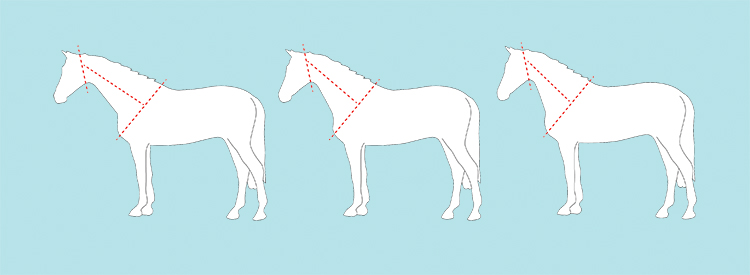
The length of a horse’s neck is important. Riders tend to like a longer neck that gives a better feeling of control and steering than a short neck. Arnaud Evain points out: “Colonel Deroches, Emeritus rider, said about the neck, that the way in which a horse uses it is more important than its length of orientation. We must respect the opinion of this horseman, but so far as possible – avoid extremes.”
On the Dutch linear score form, each conformation trait has two extremes. Take the length of the neck, “while long lines ensure flexibility and elasticity they can compromise power. Similarly a neck which is too long leads to imbalance. This principle applies to the other traits as well. In other words, a score for a trait which falls outside the average is not necessarily desirable.”
The KWPN jury looks first of all at body type and here they make a distinction between the idea type for dressage and what is best for jumping:
“In the past, a short compact horse was desirable as this body type was suited for pulling a wagon over deep clay soil. For the modern sporthorse, however, a longer back is more beneficial as it gives a horse more elasticity and athletic ability, which allows it to turn, collect and jump more easily. For these reasons, the KWPN strives for a rectangular type in all its breeding directions.”

The jumping stallion, Jasper, shows a downward slope
“With respect to body direction (upward versus downward) the ideal body direction for a dressage horse is upward, while a more horizontal body is better for a show jumper. An upward body direction is advantageous in a dressage horse, as the goal in the discipline is developing an elevated forehand and a hind leg which steps powerfully under the body. To that end, an upward body direction makes achieving that goal easier. Although a show jumper also benefits from equal weight distribution over four legs when collecting, shortening and lengthening between obstacles, an upward body direction can curtail its ability to bascule over an obstacle. When a horse bascules, he rounds the body, lowers the neck and jumps with an elevated wither, all of which are essential for optimum body use.”
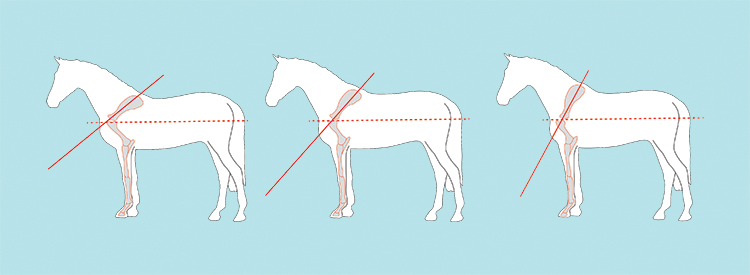
The shoulder position is the angle the shoulder blade forms with the horizontal axis. The shoulder can range from sloped to moderate to straight. Once again, Arnaud offers his insight: “Between the small shoulder of the Landgraf progeny to the powerful shoulder of the heirs of Ibrahim, this is a decision the breeder must appreciate and choose.”
Okay, so let’s have a look at arguably the greatest dressage horse ever – Valegro. As you can see he certainly has that upward tendency, and a nicely sloped shoulder. Although it might be noted in passing that the KWPN stallion commission rejected him as a breeding prospect…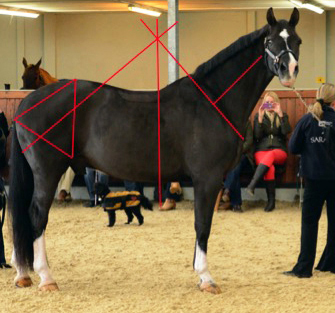 Now that’s upwards – Valegro
Now that’s upwards – Valegro
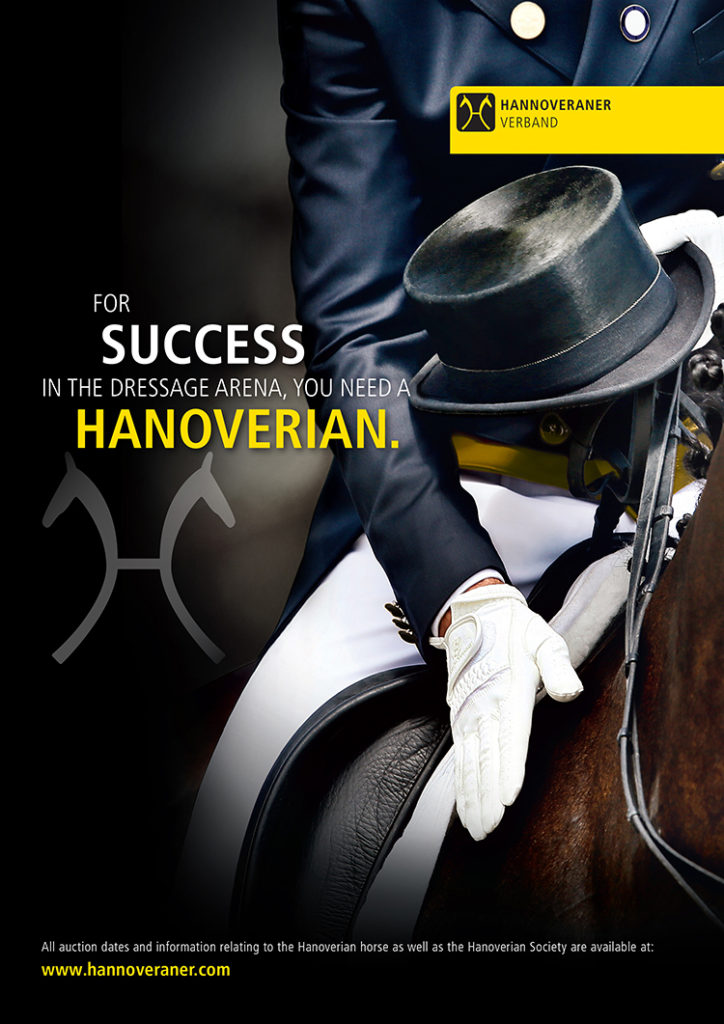
But let’s look at arguably the most successful jumping horse stallion in the world today – For Pleasure.
For Pleasure doesn’t conform to the KWPN thinking that the jumper should be horizontal. He’s a short horse with quite an upward tendency. In fact, For Pleasure is seemingly one of those jumpers that startled the Hanoverian breeding authorities when they discovered that the better the jumper, the worse the conformation score. And what is more, For Pleasure’s offspring have the same undesirable conformational traits, they just happen to be super jumpers.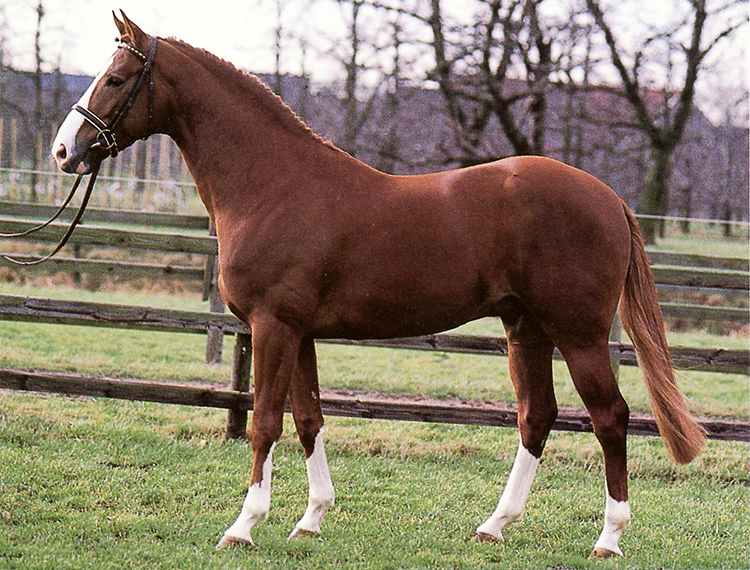
If we look at the 2015 Hanoverian Stallion Book, we find that when the mares by For Pleasure were evaluated, they had a negative value for type – 84 (100 is the mean, above indicated, good, below, bad), there is even a negative for the head – 81 (odd since he was quite a cute guy), a very negative value for the neck – 77. There is even a negative correlation between saddle position and jumping ability, as these mare evaluation tests would seem to bear out, the mares produce a score of 92 for saddle position, and 92 for frame. Breed and sex type, rated 89…
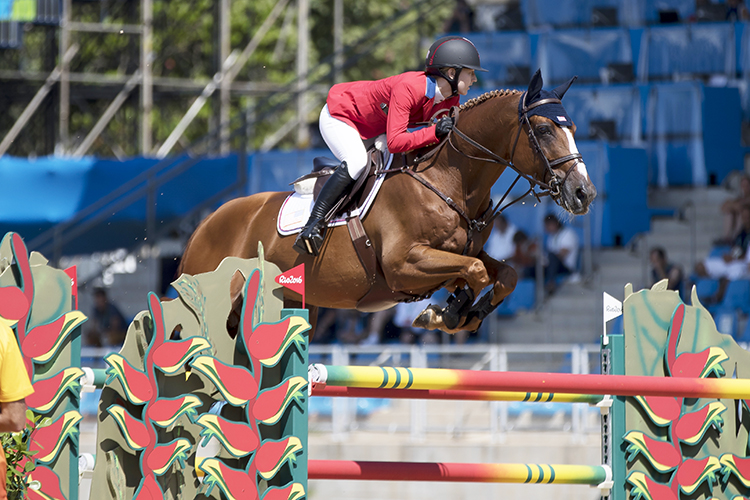
They may not win mare conformation classes, but they can jump – Barron at Rio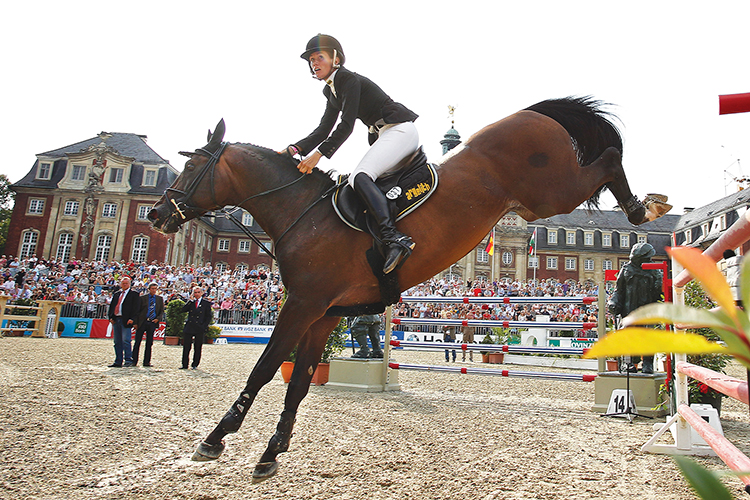
Stakkato, just 66 for ‘type’
And yet, when the results of these mare tests was added to the results of the auction inspections, For Pleasure has a wonderful index of 152 for jumping, 148 for technique, and 154 for scope. You can find the same result over and over again – Stakkato, jumping index 153, score for type – 66; Balou du Rouet, jumping, 149, type, 92, in fact of the 33 jumping sires on the Hanoverian standings with a jumping value of 120 or more, 17 have a negative score for type.
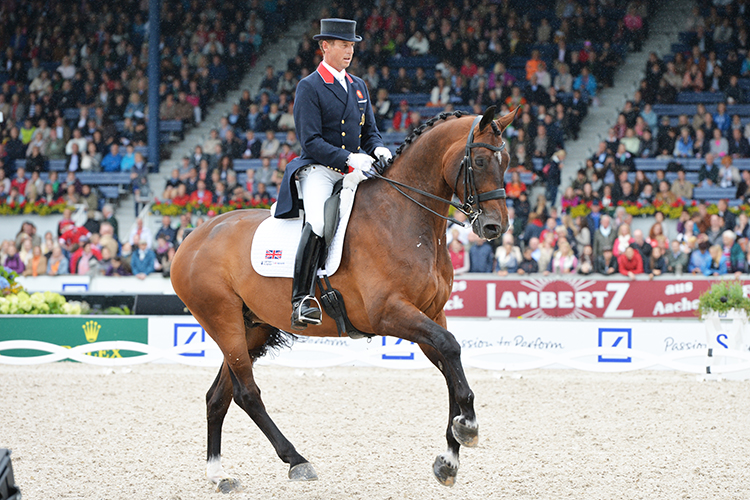
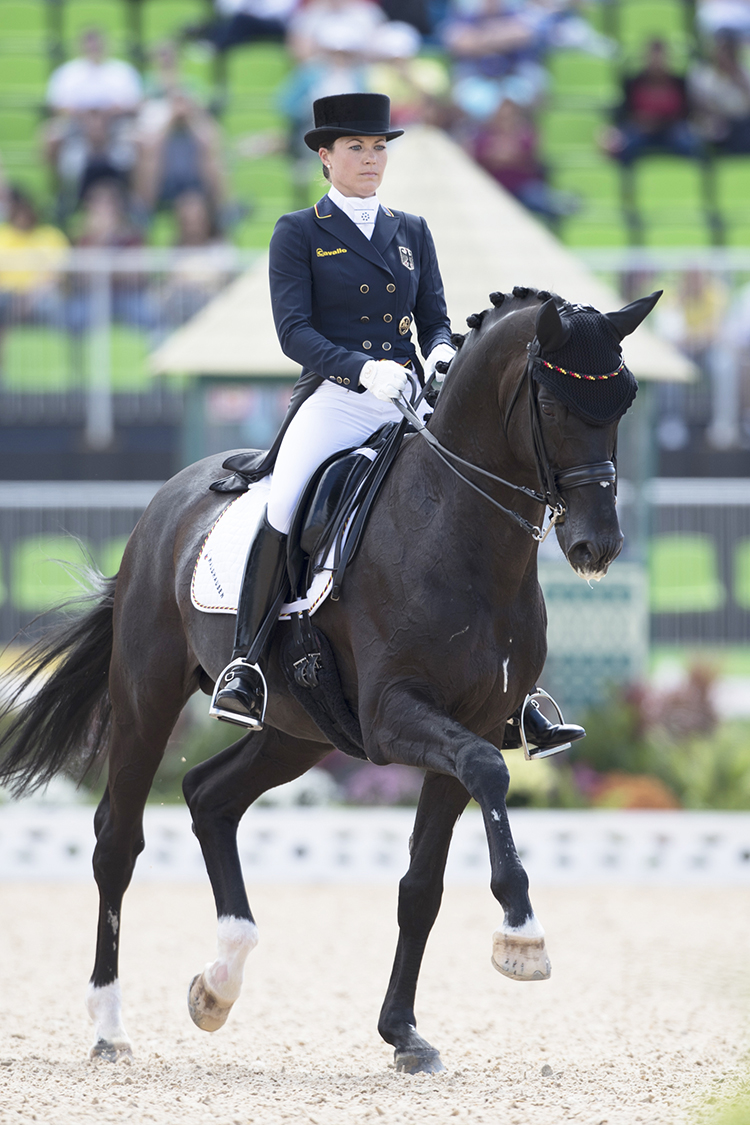
Nip Tuck and Desperados – they come in all shapes!
story continues below the advertisement
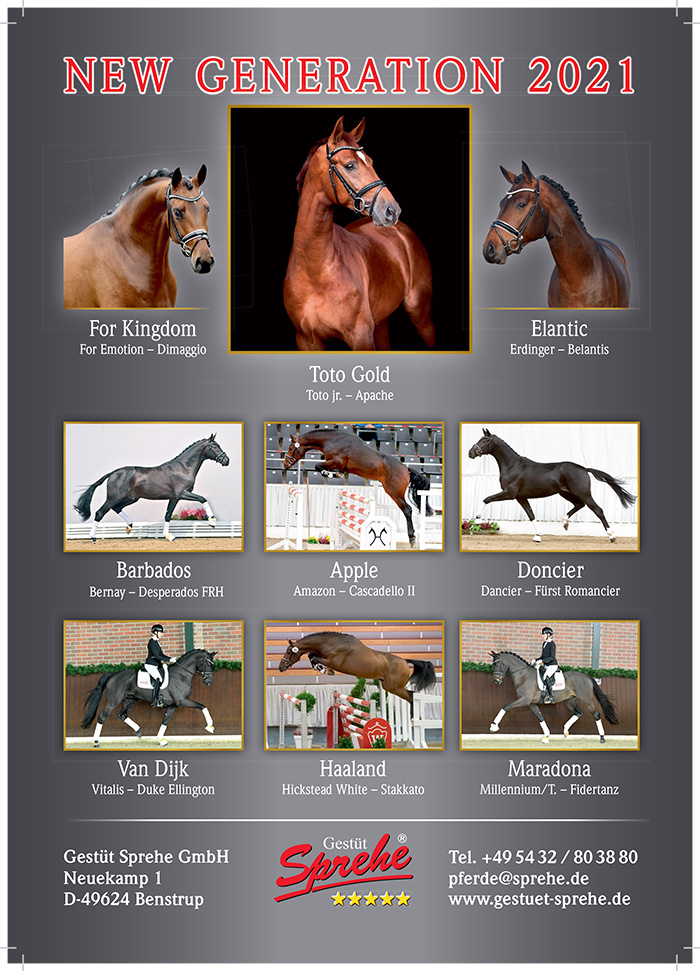
I asked my friend Ludwig Christmann, who was the person who originally discovered the negative correlation between conformation and jumping ability, if any further study had been done, or perhaps an attempt to revise conformation values for jumpers. Ludwig’s response is, as always, worth thinking about:
Dear Chris,
You are very good in asking simple questions, which are not so easy to answer. There was no follow up to my study in Germany, so it is difficult to answer your question on a scientific base. Correlations now would be different as our population has developed over the last 20 years. From experience there are a few conformation issues, where I would say, this is ok for a jumping horse, but not for a dressage horse, for example lower set necks, a more downhill build, a flatter croup or a bit more roached in the loin, but I still do not think that you can predict jumping ability just from conformation.
With regards to the Grand Prix dressage horse versus the young horse super star, I do see a development. When you look at the horses at the Olympics then you see more and more elegant dressage horses, for example in the German team. Desperados, Showtime and Weihegold were very successful young horses and had a straight career towards Grand Prix. But you still have some stockier types like Nip Tuck, who also does the job. What does this tell us? A horse does not have to be a beauty to be a successful Grand Prix horse, but it can.
Looking for elegance? A modern dressage horse? Go to www.ihb.com.au Stallions like Fürstenball are available in Australia
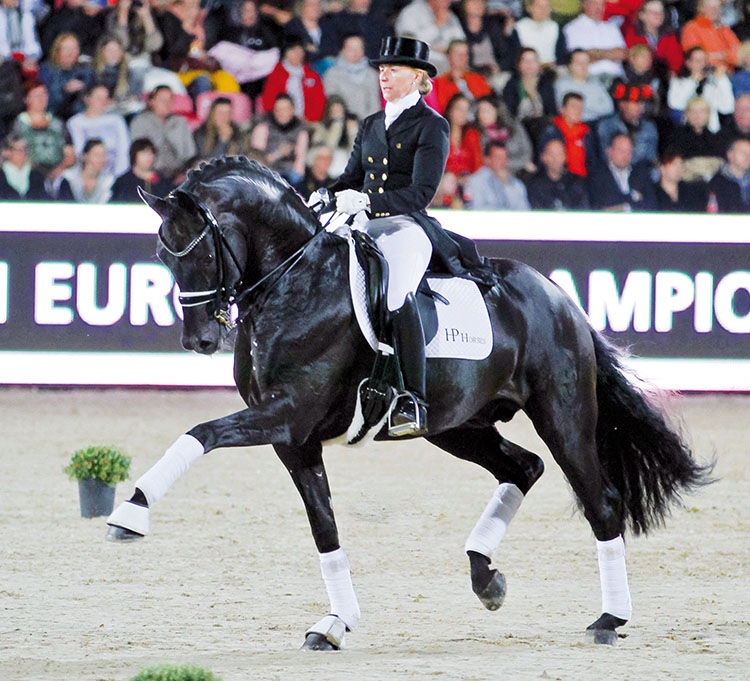



To me Jasper looks level and definitely not downhill and looks square as opposed to rectangular but he definitely has the moderately level croup of jumpers that open well behind. He also has the slightly shorter, upright humerus/arm bone needed for a quick and tight-legged front end take-off of a jumper. His neck is set into his shoulder ideally and comes out at the moderate angle desired for jumpers. For Pleasure who along with the SF breeding lines appear to have dominated the most successful Rio Olympic jumpers. To me in the photo provided for For Pleasure in the article makes him look more rectangular and has the longest neck (esp. compared to Jasper) but I remember other photos of For Pleasure and many of his sons that show him to have a rather longer and very level or horizontal shaped croup than seen in this photo. This as I mentioned before seems to go with horses that open their stifles and can stretch or kick back with their hind legs over very tall jumps. Notice that all the horses pictured have moderately open hock angles and are long from point of hip to the rear end of the pelvis with femur’s that tip well forward to the stifle, making the stifle angle smaller and bringing this joint forward under the point of hip. These characteristics are good for both jumpers and dressage horse because it keeps the hind cannons under the rear quarters of the horse when it is vertical to the ground thereby maximizing the ability to push both up and forward and minimizing the stress on the hocks and lower legs. I have not seen much association of the shoulder angle with performance maybe because if the rib cage is structured right and the elbows are forward with a high placed shoulder and open shoulder angle the horse can still maximize the front leg lift and reach. In Valegro’s photo he does not look very up-hill in his body direction (though his neck is well-set and high in its angle) but he does have a very open, sloping shoulder with the front leg set at the very front of the chest (mind you this is a very American Saddlebred and harness horse type characteristic:) and ideal hindquarter proportions, stance and is very sloping croup with ideally placed L-S joint. He is definitely shorter legged than the average current dressage horse though I think he would still be classified as more square than rectangular when comparing his body length to his height at withers. I have been looking for years for conformation that enhances elasticity and suppleness believing up to now that it must be more related to the soft-tissue characteristics of conformation, but recently at the hints of others, I think it might be found more in horses that are a little low in the back just behind the withers. Which tend to show the “swing” in the topline most describe as desirable. I am not sure from a long-life soundness issue this is desirable but top FEI horses can’t seem to succeed without it today. Thanks for your great article but I would like to point out that it benefits no one to draw lines on conformation photos of horses that are not anatomically consistent and have absolutely no relation to the subject at hand. Unlike your referenced experts I believe that we are already relating conformation very directly to the performance type of a horse as long as people understand that the body is a complex system and there will always be some limited compensation of one part for another for one to still get a super athlete. I think the KWPN has proven over the last few decades that by refining their conformation selection process that progress can be made to separate the conformation in a jumper from that of a dressage horse. However, one cannot ignore issues that affect long term soundness in this process, which I think is being sacrificed in some instances today in stallion selections. Over-bent hocks and long and/or soft pasterns, especially in the hind leg are not suited to upper level dressage or jumping horses.
I agree with Sandi. Part if what makes a hirse outstanding is the horse wants to do it..heart.
Dr. Hilary Clayton studued dpirt horse conformation.
I like the photos you used
It is actually the shorter backed horses that collect better than longer backed horses. That is why Spanish horses tend to excell at it because they tend to be shorter backed. Longer backed horses are better at extending.
And shoulder and fetlock angles are influenced by hoof balance.
Nice comment Sandi! Very insightful info, thanks for sharing!
Thank you for this article. It scientifically leaves room for improvement but I surely think you asked the right questions! In my experience as a rider, breeder and vet I’ve come to the conclusion that the most important ingredient to success in the sport is the part that is hidden from the deathgrip of human judging sheets because it sits neatly hidden in the interior. It’s called will to perform and whatever marks a stallion or mare gets during their performance test is flawed to begin with because neither are the testing sites comparable nor are the riders and when it comes to the topsport the rider is more than half of the equation. In the veterinary world there is little that is agreed upon unisono but one of these topics is that breeding for physical extremes that are very far from the wild-type of any given species is inevitably creating soundness problems. Whether you look at the respiratory distress of the modern pug or the satiric picture many German Shepherds have assumed with the fashion of extremely slopy toplines and crushed hips. Just weeks ago that photograph has hit social media of the Arab youngster with an extremely narrow rostrum asking the same question “can this still be functional”. For years (starting with correspondence that happened in 2005/06) I have pushed for efforts to establish a breed value for soundness within the Hanoverian Verband because before anything the rider/owner wants an animal that is sound and has a long career. This was notably years after such systems had already been in place in livestock-breeding so could have easily been copied and put to use within a few years.
Result/echo? Nil.
About seven years later (2013) the German FN finally announced that a group of breeding scientist and veterinarians had been teamed and was working on a database to collect information from the German Sporthorse population. And another 5 years later all we have in terms of results is a nicely done glossy brochure spread with all the breeding magazines announcing great things and zero information beside the FN press releases being leaked to the veterinarian public. I’ve gone to great lengths to keep myself informed about the process but questions asked by email or phone weren’t answered and nothing was released into the customary channels that reliably bring the latest research results to us equine vets either.
Meanwhile what does leak through left right and centre is that KWPN has made itself the spearhead of improving equine soundness in breeding. Umm yes what do we have there? An OCD index. OCD the scary and deadly disease performance horses succumb to left right and centre… – not. All the rage with OCD is because a) because someone was smart enough to turn it into a PPE issue and b) because any idiot can find it on an x-ray whereas it is a lot more difficult to find out whether this or that horse creates a five figure vet bill year after year. The OCD index is the right step but taken in the wrong direction. I’d be a lot more concerned why we see so many fertility issues nowadays and why the average lifespan of our horses is lower today than it was back in the old days when horses still had to perform working chores during the week and showing chores on the weekend AND were mass-killed during wars with a large percentage of the equine population just wiped out by cannonfire or starvation. The medical care for many horses is better than for humans today. More old horses are kept alive today than ever. Yet we see a lower percentage of older horses on average. How can this be if all we do in terms of breeding is correct? And are these facts never addressed but instead we get hung up on whether or not this or that stallion is longbacked, shortbacked or built uphill? We’re a bit indoctrinated there by hundreds of years of doing things a certain way. Whoever pointed out that Valegro should not have been denied breeding rights I agree with you. There are many more who were ‘almost missed’s’ such as Donnerhall, Rubinstein etc.
All this happens while our equestrian world has more or less come under full attack by questionable animals rights activists around the world and we should be even more vigilant to keep tabs on welfare issues both within our own sphere than ever.
But what happens? The FEI takes little to no action about substantial welfare violations like I have pointed out in to them in writing complete with photographs, dates and time repeatedly (e.g. in 2015). Our international governing body is more concerned whether a Sjef Janssen gets his pants in a knot over an interview because it contains some polite hints between the lines that are not to his liking. Conflict of interest – my a*** I darn well see a conflict of interest there. But it’s on the FEI’s side quite clearly.
Another aspect I would like to note is that imo we have far more horses today who have it in them to excel into the top ranks than 15 years ago. What we are sorely missing are the riders to bring them out to their full potential. The average buyer today has seldom mastered the challenge of acquiring a correct seat. be independent from their hands and not get in the horse’s way by softly moving with it rather than against it. Developing these skills takes time and effort and investing this kind of dedication has become hugely unpopular so horses are expected to compensate for a lot of human shortcoming. There is a whole different mindset required to qualify as a rider namely to be critical of yourself, appreciative of what you have and willing to practice. Highly unfashionable and one of the reasons why every young dressage horse for sale today is expected to have ‘FEI potential’ even when the rider needs to go on a lungeline and has no business showing whatsoever for another 2 years.
I’ve found the majority of horses today is not trained to but prevented from developing into the best sporthorse they can be. Besides it seems counterproductive to breed solely for that once in a million top athlete when 90% of your market is not showing under saddle at all and the majority of the remaining 10% will crawl around at maximum intermediate level. We should be way more worried to improve the soundness of our horses and our biggest concern should be to improve our sport and riding. In the current situation this would be far more helpful than picking on any given horse’s conformation.
A few years back I have suggested (also to the Hanoverian Verband) to open a second line of studbooks designed specifically for the top ranks of the sport. Breeders should have options and the criteria for the various segments of our market are grossly diverging both in terms of physique, movement, athletic ability and interior values. The average horseperson wants a safe, sound animal of certain size and ability. Most adult riders can not handle an overly reactive, sharper horse whereas if you are looking for the speed to win 1.60 or take one to GP competitively you will definitely want that extra ounce of nerve.
Valegro was rejected because the correct breedingleaders have no clue any more about the balance (Das Gleichgewicht) in the skeleton. Balance is beauty is timeless
Oberlandstallmeister Dr. Gustav Rau and the other experienced Landstallmeisters always talked about the importance of the equilibrium (Das Gleichgewicht) in the construction of a horse.. We call it the equilibrium model. So everything revolves around the proportions in the skeleton and the derived mechanism. Only with a faultless functioning skeleton mechanism a horse can move optimally the total mass in balance. Balance is always the result of the tact that the horse manifests. And tact is always the result of a balanced construction. The genial Oberlandstallmeister Dr. Gustav Rau described the equilibrium model in 1910 as follows: “If the harmony and balance in the construction of the horse-and the resulting balanced movements-are missing, people are imagine the balance. In this area the fantasy of people has no limits and they make the laws of nature subordinate to their rich fantasy. You do not get riding skills by supply of the English Thoroughbred (race skeleton). First of all there is an uniform type required. The building blocks consist of a combination of length-width and height dimensions and forms of the skeleton. With an uniform type, an unified skeleton, uniform ratios, equal propulsion- a combination of equal elements required for the requested performance. Only if these uniform elements are present, then the whole breeding is equal in the performance. The more types you have in the breeding population, the greater are the disadvantages.” Harmony
Based on this detailed description, I then outlined the dimensions and proportions at the skeleton. It goes without saying that these eye-catching harmony is only possible if the skeleton ratios are pure aligned with each other. It are not the muscles that move a horse at its best and they are also not responsible for a long lasted performance but the pure function of the skeleton mechanism constitutes the connecting factor.
A crucial part of the skeleton mechanism is the lowering backhand. The lowering backhand enables the horse to bring the surplus of the weight at stand at a well-balanced built horse of 60% on the forehand to 50% over the supporting legs of the front and back hand and move the mass forward in balance. A lowering back hand is effected by the pelvis that should be able to tilt forward in the movement to make the underlying joints smaller via the ball joint of the iliac joint. This process is called the loins mechanism.